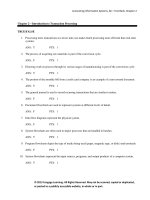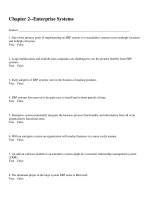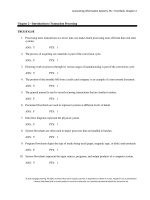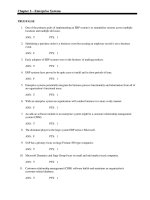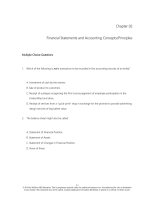Using information technology 10th edition williams test bank
Bạn đang xem bản rút gọn của tài liệu. Xem và tải ngay bản đầy đủ của tài liệu tại đây (190.14 KB, 85 trang )
Ch 002: The Internet and the World Wide Web Exploring Cyberspace
Multiple Choice Questions
1. An expression for how much data can be sent through a communications channel in a given
amount of time is referred to as ________.
A. connectivity
B. dial-up
C. bandwidth
D. download
2. Generally, a very high-speed Internet connection is referred to as ________.
A. broadband
B. dial-up
C. bandwidth
D. upload
3. The wired or wireless means of connecting a computer to the Internet is called a ________.
A. broadband
B. physical connection
C. dial-up
D. bandwidth
4. Bps stands for ________.
A. bytes per second
B. bits per second
C. bandwidth per second
D. broadband per second
5. Megabits per second are ________.
A. 1 million bits per second
B. 10,000 bits per second
C. 1,000 bits per second
D. 100 bits per second
2-1
Ch 002: The Internet and the World Wide Web Exploring Cyberspace
6. Gigabits per second are ________.
A. 1 hundred bits per second
B. 1 thousand bits per second
C. 1 million bits per second
D. 1 billion bits per second
7. The transmission of data from a remote computer to a local computer is referred to as
________.
A. upload
B. download
C. broadband
D. bandwidth
8. The transmission of data from a local computer to a remote computer is called ________.
A. upload
B. download
C. broadband
D. bandwidth
9. Which of the following is NOT an example of a download?
A. Putting pictures from the Internet on your hard drive.
B. Storing a map for your vacation from the Internet on your hard drive.
C. Saving a presentation to a CD.
D. Saving a program from an Internet site to your hard drive.
10. Which of the following is NOT an example of an upload?
A. Sending a photograph as an email attachment.
B. Saving your favorite music videos from a music website to your hard drive.
C. Sending a spreadsheet as an email attachment.
D. Submitting a term paper to an instructor online.
2-2
Ch 002: The Internet and the World Wide Web Exploring Cyberspace
11. The Internet connection that uses regular phone lines to transmit data in megabits per
second is ________.
A. T1 line
B. cable modem
C. DSL line
D. communications satellite
12. Which of the following is NOT an advantage of DSL?
A. fast download
B. connection always on
C. consistent transmission rate
D. universal availability
13. Which traditional trunk line carries 24 normal telephone circuits and has a transmission
rate of 1.5-6 Mbps?
A. T1 line
B. cable modem
C. DSL line
D. communications satellite
14. What connects a personal computer to a cable-TV system that offers an Internet
connection?
A. T1 line
B. cable modem
C. DSL line
D. communications satellite
15. The method of going online that requires the user to be no more than about 3 miles from a
phone company central switching office is ________.
A. dial-up modem
B. DSL
C. T1 line
D. satellite
2-3
Ch 002: The Internet and the World Wide Web Exploring Cyberspace
16. The line most commonly used by corporate, government, and academic sites is
________.
A. DSL
B. T1 line
C. satellite
D. ISDN
17. Which of the following is NOT an advantage of a T1 line?
A. affordability
B. high-speed transmission
C. 24 separate circuits
D. supports many users
18. A space station that transmits radio waves called microwaves from earth-based stations is
called a ________.
A. T1 line
B. cable modem
C. DSL line
D. communications satellite
19. ISP stands for ________.
A. Internet select provider
B. Internet service provider
C. Internet serial provider
D. Internet service pusher
20. A point of public access to a Wi-Fi network is called a(n) ________.
A. cable connection
B. Internet Exchange Point
C. hotspot
D. POP
2-4
Ch 002: The Internet and the World Wide Web Exploring Cyberspace
21. Using a user name and password, the ISP will allow the user to connect, or to ________,
to the Internet.
A. log on
B. download
C. upload
D. switch
22. A secret word or string of characters that allows you to log on to a remote computer is
called a ________.
A. password
B. website
C. URL
D. UserID
23. Software that enables users to find and access the various parts of the web is called a
________.
A. home page
B. website
C. browser
D. web page
24. A computer with a domain name is called a ________.
A. web page
B. website
C. home
D. web portal
25. The .gov, .com, .net, and .edu extensions are examples of ________.
A. emoticons
B. FAQs
C. top-level domains
D. URLs
2-5
Ch 002: The Internet and the World Wide Web Exploring Cyberspace
26. A set of communications rules for exchanging information is called a(n) ________.
A. web browser
B. HTML
C. URL
D. protocol
27. The communications rules or protocols that allow browsers to connect with web servers
are ________.
A. HTTP
B. HTML
C. Java
D. URL
28. The set of special instructions that are used to specify document structure, formatting, and
links to other multimedia documents are called ________.
A. HTML
B. hypertext
C. multimedia
D. web portal
29. Connections to other documents or web pages that contain related information are called
________ links.
A. web portal
B. multimedia
C. URL
D. hypertext
30. A specific web address for specific information is called a ________.
A. home page
B. web page
C. URL (Uniform Resource Locater)
D. web portal
2-6
Ch 002: The Internet and the World Wide Web Exploring Cyberspace
31. The first page seen at a website is called the ______.
A. community page
B. home page
C. browser
D. protocol
32. Little circles located in front of various options, which can be selected with the mouse, are
called ________.
A. hyperlinks
B. radio buttons
C. text boxes
D. web portals
33. An independently controllable section of a web page is called a ________.
A. hyperlink
B. web site
C. frame
D. window
34. Websites that group together in one convenient location popular features such as online
shopping malls, email support, community forums, current news and weather are called
________.
A. home pages
B. browsers
C. search engines
D. web portals
35. The subject word (or words) of the topic you wish to find while using a search engine is
called the ________.
A. directory
B. URL
C. keyword
D. web portal
2-7
Ch 002: The Internet and the World Wide Web Exploring Cyberspace
36. Which of these provides lists of several websites classified by topic?
A. web portal
B. subject directory
C. metasearch engine
D. browser
37. Which of these can be used to locate information on the web by asking questions or using
keywords?
A. search engines
B. home pages
C. community pages
D. URLs
38. A search engine that allows you to search several search engines simultaneously is called
a ________.
A. megasearch engine
B. hypersearch engine
C. metasearch engine
D. none of these
39. If you were emailing a term paper and wanted to maintain its formatting, it would be sent
as a(n) ________.
A. URL
B. instant message
C. listserv message
D. attachment
40. Any user on a given email system can send a message and have it pop up instantly on the
screen of anyone else logged onto that system using ________.
A. attachments
B. instant messaging
C. list-serves
D. spam
2-8
Ch 002: The Internet and the World Wide Web Exploring Cyberspace
41. A method whereby one can connect to a remote computer and transfer files to his or her
own microcomputer's hard disk via TCP/IP over the Internet is called ________.
A. URL
B. FTP
C. ARAP
D. SLIP
42. Which of the following is an FTP client program?
A. Cute
B. Put
C. Grab
D. FTP net
43. To access a newsgroup, a(n) ________ program is needed.
A. browser
B. applet
C. newsreader
D. chat
44. An automatic email mailing list of people who regularly participate in discussion topics is
called ________.
A. attachments
B. instant messaging
C. listserv
D. spam
45. Which of the following is NOT an example of good netiquette?
A. Consult the frequently asked questions (FAQs).
B. Don't SHOUT.
C. Don't send large file attachments, unless requested.
D. When replying, send the entire original message for reference.
2-9
Ch 002: The Internet and the World Wide Web Exploring Cyberspace
46. Which of the following is NOT an example of flaming?
A. a lie
B. an ethnic joke
C. profanity
D. a sexist comment
47. A program that adds a specific feature to a browser, allowing it to play or view certain
files, is a ________.
A. script
B. plug-in
C. tag
D. cookie
48. Small Java programs that can be quickly downloaded and run by most browsers are called
________.
A. cookies
B. applets
C. active X
D. hypertext
49. The rapid sequencing of still images to create the appearance of motion is called a(n)
________.
A. animation
B. hyperlink
C. script
D. applet
50. The technology in which software automatically downloads information to your computer
is called ________.
A. pull technology
B. download
C. push technology
D. upload
2-10
Ch 002: The Internet and the World Wide Web Exploring Cyberspace
51. The technology in which customized text, audio, and video are sent automatically to the
user on a regular basis is called ________.
A. webcasting
B. broadcasting
C. surfing
D. attaching
52. Web logs made by various users that are accessible to others are called ________.
A. real-time chat
B. blogs
C. telnet
D. applets
53. RSS newsreaders are also known as ________.
A. attachments
B. aggregators
C. podcasters
D. webcasts
54. Which of the following is a person-to-person auction site?
A. www.acponline.org
B. www.ebay.com
C. www.onSale.com
D. www.thirdage.com
55. Trading, banking, and e-money can be classified as ________.
A. online finance
B. online job-hunting
C. online matchmaking
D. online auctioning
2-11
Ch 002: The Internet and the World Wide Web Exploring Cyberspace
56. In terms of privacy, email is like ________.
A. a sealed letter
B. an insured package
C. a postcard
D. a notarized document
57. ________ is an example of "thoughtcasting," or "microblogging."
A. Spam
B. Spoofing
C. Twitter
D. Flickr
58. An uninvited email solicitation to buy something is an example of ________.
A. flaming
B. spam
C. netiquette
D. list-serve
59. Forging of an email sender name so that the message appears to have originated from
someone or somewhere other than the actual source is called ________.
A. spoofing
B. phishing
C. pharming
D. spyware
60. Adware is also called ________.
A. cookies
B. spam
C. pop-up generators
D. aggregator
2-12
Ch 002: The Internet and the World Wide Web Exploring Cyberspace
61. One type of spyware is ________.
A. browser hijackers
B. search hijackers
C. key loggers
D. All of these
True / False Questions
62. Bandwidth is an expression of how much data can be sent through a communications
channel in a given amount of time.
True False
63. The wired or wireless means of connecting to the Internet is called a physical connection.
True False
64. Bps stands for bandwidth per second.
True False
65. One kilobit per second is the same as 1 million bits per second.
True False
66. Kilobits per second are faster than megabits per second.
True False
67. Mps stands for megabits per second.
True False
2-13
Ch 002: The Internet and the World Wide Web Exploring Cyberspace
68. The term "gigabit" refers to 1 billion bits per second.
True False
69. Upload is the transmission of data from a remote computer to a local computer.
True False
70. Downloading is the transmission of data from a local computer to a remote computer.
True False
71. The transmission of the latest pinball game off a subscriber network to a home computer
is an example of an upload.
True False
72. The transmission of credit information to order something online is an example of an
upload.
True False
73. Digital subscriber line (DSL) uses satellite technology to transmit data in megabits per
second.
True False
74. The primary advantage of DSL is that it is always on and its transmission rate is
consistent.
True False
75. A T1 line is essentially a traditional trunk line that carries 24 normal telephone circuits
and has a transmission rate of 1.5-6 Mbps.
True False
2-14
Ch 002: The Internet and the World Wide Web Exploring Cyberspace
76. A cable modem connects a personal computer to a cable-TV system that offers an Internet
connection.
True False
77. A cable modem is an example of a physical connection to the Internet.
True False
78. Cable modem lines are shared with other cable users in a particular area and can be slower
during peak use periods.
True False
79. You can have a cable modem Internet connection even if there is no cable television
available in your area.
True False
80. The primary advantage of a T1 line is its affordability.
True False
81. A DSL line can be installed anywhere as long as the user has a telephone line.
True False
82. A communications satellite, a space station that transmits radio waves called microwaves
from earth-based stations, can be used to retrieve information from the Internet.
True False
83. ISP stands for Internet service provider.
True False
2-15
Ch 002: The Internet and the World Wide Web Exploring Cyberspace
84. Wi-Fi refers to a group of 802.11 standards established by the IEEE (Institute of Electrical
and Electronic Engineers).
True False
85. An Internet service provider (ISP) provides users with access to the Internet.
True False
86. ISPs provide each user with a point of presence as a local access point to the Internet.
True False
87. Every computer connected to the Internet has the same IP address.
True False
88. ICANN runs the Internet.
True False
89. A browser is a document on the World Wide Web that can include text, pictures, sound,
and video.
True False
90. The URL is the website's unique address.
True False
91. A website is the location of a web domain name in a computer (server) somewhere on the
Internet.
True False
2-16
Ch 002: The Internet and the World Wide Web Exploring Cyberspace
92. A URL is a string of characters that points to a specific piece of information on the web.
True False
93. HyperText Transfer Protocol, or HTTP, refers to the communications rules that allow
browsers to connect with web servers.
True False
94. A domain is simply a location on the Internet.
True False
95. HTML is the set of special instructions that are used to specify document structure,
formatting, and links to other documents.
True False
96. The first page seen at a website is called the community page.
True False
97. Radio buttons are little circles located in front of various options; selecting an option with
the mouse places a dot in the corresponding circle.
True False
98. Scroll arrows, small up/down and left/right arrows, can be used to move the screen to see
the rest of the web page.
True False
99. A frame is an independently controllable section of a web page.
True False
2-17
Ch 002: The Internet and the World Wide Web Exploring Cyberspace
100. A portal is software that enables users to view web pages and to jump from one page to
another.
True False
101. Search engines are websites that group together in one convenient location popular
features such as search tools, email, electronic commerce, and discussion groups.
True False
102. A subject directory allows you to search for information by selecting lists of categories
or topics.
True False
103. Search engines are programs that enable you to ask questions or use keywords to help
locate information on the web.
True False
104. A metasearch engine is an individual search engine.
True False
105. Email can be sent via a particular email program, such as Microsoft Outlook, or via a
browser and a website, such as through Hotmail and Gmail.
True False
106. Some commonly used top-level domains are .net, .com, .gov, and .edu.
True False
107. Many viruses can ride along on email attachments.
True False
2-18
Ch 002: The Internet and the World Wide Web Exploring Cyberspace
108. Instant messaging can be used to post advertisements on computer screens.
True False
109. With instant messaging, any user on a given email system can send a message and have
it pop up instantly on the screen of anyone else logged onto that system.
True False
110. FTP is used to transmit only small files.
True False
111. A listserv is an automatic mailing list server that sends email to subscribers who
regularly participate in discussion topics.
True False
112. Guides to appropriate online behavior are called netiquette.
True False
113. Most online groups post frequently asked questions (FAQs) that explain expected norms
of online behavior for a particular group.
True False
114. Use of all-capital letters on the Internet is considered appropriate online behavior.
True False
115. Flaming refers to unsolicited email in the form of advertising or chain letters.
True False
2-19
Ch 002: The Internet and the World Wide Web Exploring Cyberspace
116. Internet telephony is the method of using the Internet to make a phone call, either one-toone or for audio conferencing.
True False
117. Applets are small programs that can be quickly downloaded and run by most browsers to
support multimedia.
True False
118. Applets are written in Java, a complex programming language that enables programmers
to create animated and interactive web pages.
True False
119. Streaming video is the rapid sequencing of still images to create the appearance of
motion, such as in a cartoon.
True False
120. Streaming audio allows you to listen to a file while the data is still being downloaded to
your computer.
True False
121. Pull technology automatically downloads information to your computer.
True False
122. Webcasting sends customized text, video, and audio to your computer automatically on a
regular basis.
True False
2-20
Ch 002: The Internet and the World Wide Web Exploring Cyberspace
123. RSS newsreaders and RSS aggregators are the same thing.
True False
124. "Web 2.0" refers to a more social, collaborative, interactive, and responsive web.
True False
125. Twitter is a social-networking website.
True False
126. Spam consists of little text files left on your hard disk by some websites you visit.
True False
127. Spamming is writing an online message that uses derogatory, obscene, or inappropriate
language.
True False
128. In pharming, thieves implant malicious software on a victim's computer that redirects the
user to an impostor web page even when the individual types the correct address into his or
her browser.
True False
Fill in the Blank Questions
129. The type of data transmission that allows only one signal at a time is called ________
transmission.
________________________________________
2-21
Ch 002: The Internet and the World Wide Web Exploring Cyberspace
130. When several signals can be transmitted at once, it is called ________ transmission.
________________________________________
131. The wired or wireless means of connecting to the Internet is called a(n) ________
connection.
________________________________________
132. Data is transmitted in characters or collections of ________.
________________________________________
133. The speed of a modem that is 56,000 bps can be expressed as ________ Kbps.
________________________________________
134. One Gbps is approximately 1 ________ bits per second.
________________________________________
135. A device that sends and receives data over telephone lines to and from computers is
called a(n) ________.
________________________________________
136. Downloading is the transmission of data from a(n) ________ computer to one's own
computer.
________________________________________
137. Transmitting data from a local PC to a website being constructed by a user can be called
a(n) ________.
________________________________________
2-22
Ch 002: The Internet and the World Wide Web Exploring Cyberspace
138. A modem that uses telephone lines to transmit data at 56 Kbps is a(n) ________
connection.
________________________________________
139. The device that connects a personal computer to a cable-TV system that offers an
Internet connection is called a(n) ________.
________________________________________
140. A space station that transmits radio waves from earth-based stations is called a
________.
________________________________________
141. The radio waves transmitted from a communications satellite are called ________.
________________________________________
142. Communications satellites transmit data to you at a rate of 1-5 ________.
________________________________________
143. 3G and 4G wireless technology does not need Wi-Fi access points because it uses the
existing ________ system.
________________________________________
144. The Internet service provider's (ISP's) local access point for a particular area is its
________.
________________________________________
2-23
Ch 002: The Internet and the World Wide Web Exploring Cyberspace
145. To avoid making their customers pay long-distance phone charges to connect, ISPs
provide each customer with a ________.
________________________________________
146. ISPs that don't run their own backbones connect to an Internet backbone through a(n)
________.
________________________________________
147. The Internet's high-speed, high-capacity communication lines are its ________.
________________________________________
148. When two modems connect to each other at a single ISP location, the process is called
________.
________________________________________
149. A set of rules that computers must follow to transmit data electronically is called a(n)
________.
________________________________________
150. The protocol that enables all computers to use data transmitted on the Internet is called
________.
________________________________________
151. To send data over the Internet, TCP/IP breaks data into smaller blocks called ________.
________________________________________
2-24
Ch 002: The Internet and the World Wide Web Exploring Cyberspace
152. The __________ part in TCP/IP is used to send data packets across the Internet to their
final destination.
________________________________________
153. In TCP/IP, the __________ part is used to reassemble the packets in the correct order.
________________________________________
154. Every computer on the Internet has a(n) _________ address.
________________________________________
155. An IP address consists of four sets of numbers between _________ and _________.
________________________________________
156. An IP address consists of four sets of numbers separated by ________.
________________________________________
157. Each time a user connects to an ISP, the ISP assigns the computer a new IP address for
that session; the new address is called a(n) ________ address.
________________________________________
158. The group established to regulate Internet domain names is
_______________________________________________________________.
________________________________________
159. The _________ is the organizational home for groups responsible for Internet
infrastructure standards.
________________________________________
2-25

